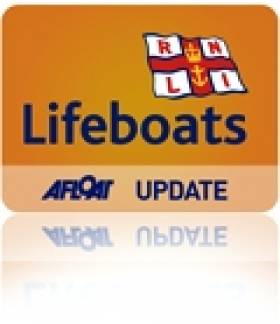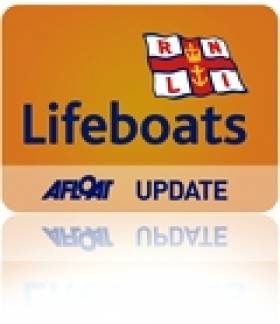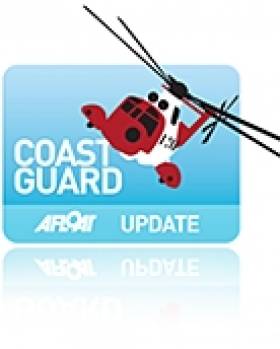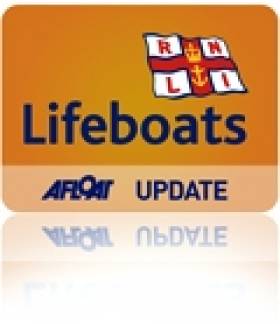Displaying items by tag: Lifeboats
Wicklow Lifeboat Launches Twice at the Weekend
Wicklow lifeboat launched at 10.07am on Sunday morning ( 25th July) to assist a 32 foot yacht with mechanical problems. The yacht was at located 11.00am 13 miles North East of Wicklow harbour becalmed and unable to motor. The lifeboat crew quickly established a towline and the yacht with 3 people onboard was taken back to Wicklow Harbour, the vessel was safely alongside the quay by 1.15pm and the lifeboat returned to station. Crew list - Coxswain Nick Keogh, Mechanic Lisa O Leary, Brendan Kavanagh Wayne Jones, John Docherty and Brian Sinnot.
A few hours later pagers were activated to alert the volunteer crew and the lifeboat put to sea again at 3.42pm, this time to give assistance to a rigid inflatable boat that had broken down with 5 people onboard near the Silver Strand. The lifeboat located the 5 metre Rib South of Wicklow head. 3 children were taken onboard the lifeboat and the Rib was towed back to Wicklow harbour, where all 5 people were landed safely.
Crew list: Coxswain Ciaran Doyle, Mechanic Lisa O Leary, Tommy McAulay , Barry Spencer, Tommy Murphy and John Docherty.

Wicklow Lifeboat Launches at the Weekend. Photo: courtesy Wicklow lifeboat
Related Safety posts
RNLI Lifeboats in Ireland
Safety News
Rescue News from RNLI Lifeboats in Ireland
Coast Guard News from Ireland
Water Safety News from Ireland
Marine Casualty Investigation Board News
Marine Warnings
Trawler Fouls Prop, Calls Lifeboat for Tow
Ballycotton lifeboat was called on to lend assistance to a 23 metre fishing vessel in difficulties, 31 miles south of Ballycotton today. The Irish registered vessel, with five on board, contacted the emergency services when they fouled their propeller. The Ballycotton lifeboat, Austin Lidbury, arrived on scene at 12:00 and established a towline. The vessel was safely towed to Ballycotton harbour.
Related Safety posts
RNLI Lifeboats in Ireland
Safety News
Rescue News from RNLI Lifeboats in Ireland
Coast Guard News from Ireland
Water Safety News from Ireland
Marine Casualty Investigation Board News
Marine Warnings
Castletownbere Lifeboat was launched this afternoon at 12.20pm to go to the assistance of a 43 ft fishing vessel taking on water 17 miles south west of Castletownbere in county Cork. To view the RNLI Video scroll down to the bottom of the post.
When the lifeboat crew arrived on scene they saw that the three crew had got into a liferaft as their fishing vessel was taking on a considerable amount of water and was in danger of sinking.
Conditions were described as fair with a large 4 metre groundswell. The Coast Guard helicopter from Shannon winched two of the fishing crew off the liferaft but a third man was in the water. Castletownbere lifeboat crew immediately recovered the man onto the lifeboat. With the casualty safely on the lifeboat, two RNLI crewmembers brought a salvage pump on board and proceed to pump the water from the fishing vessel. It was then taken under tow by the lifeboat and brought back to the harbour.
The rescued man did not need any further medical attention. The Irish Navel vessel the LE Eithne was also on scene during the rescue. Commenting on the callout Castletownbere RNLI crewmember Paul Stevens said, “ This callout thankfully resulted in a happy ending with three men being brought to safety. We were also able to bring the fishing vessel ashore in one piece. I am sure the three men are in shock but they had a lucky escape.”
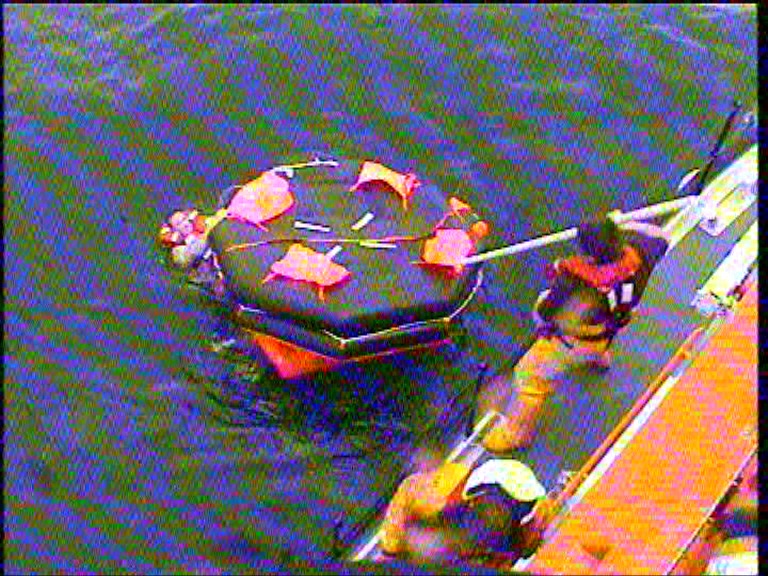
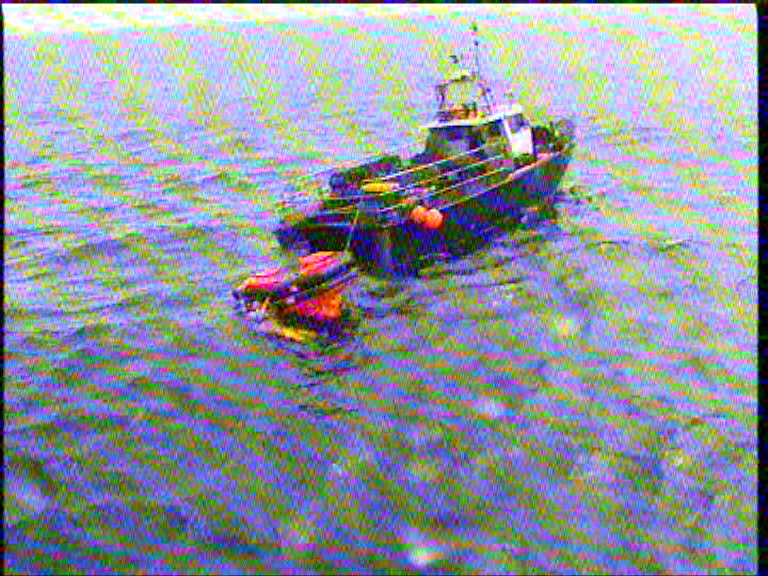
Related Safety posts
RNLI Lifeboats in Ireland
Safety News
Rescue News from RNLI Lifeboats in Ireland
Coast Guard News from Ireland
Water Safety News from Ireland
Marine Casualty Investigation Board News
Marine Warnings
Lifeboat Creates Wash to Assist Yacht Aground
Baltimore RNLI inshore lifeboat Bessie, was launched this morning to assist a yacht that had gone aground at an area called the Sound, North West of Baltimore Harbour. The alarm was raised at 11:52am when the 36ft Sun Odyssey yacht was seen aground across the Harbour. Helmsman Youen Jacob with his crew of Kieran Collins and John McDonagh made their way to the stricken vessel on an RNLI twin engine Atlantic 75 RIB. On arrival at the scene they found the crew hauling on their anchor line in an attempt to pull themselves off the rocks. The inshore lifeboat gave assistance by creating a wash which lifted the boat from its rocky perch. The lifeboat then escorted the yacht back to Baltimore Harbour. The yacht did not suffer any significant damage and all four passengers on board, two men and two women were uninjured.
Related Safety postsRNLI Lifeboats in Ireland
Safety News
Rescue News from RNLI Lifeboats in Ireland
Coast Guard News from Ireland
Water Safety News from Ireland
Marine Casualty Investigation Board News
Marine Warnings
At 5.45pm yesterday evening Monday July 5th, Fenit RNLI Lifeboat launched to assist a 40 foot Catamaran which was taking on water. The vessel which had left Donegal en route to France was 20 miles west of Loop Head and there were 2 people on board.
On arriving at the location of the stricken vessel volunteer crew members with Fenit RNLI Lifeboat immediately boarded the catamaran with a salvage pump and proceeded to pump the water from the vessel. Once they were happy that this process was working satisfactorily they put the vessel on tow and proceeded towards Fenit.
On arrival back in Fenit just before 1am this morning, arrangements were in place by Fenit RNLI members on shore and the catamaran was lifted onto the Pier by the Fenit Harbour Board Crane.
iPhone Co-Ordinates Save Stricken Vessel
A stricken vessel was located in trouble on Lough Erne using lat/long data from an iPhone.
A 999 call from the Motor Cruiser ‘Wee Rascal’ on Lough Erne in the early hours of this morning called on all the investigative powers of Belfast Coastguard as the vessel wasn’t even close to its reported position.
The vessel was on passage from Kesh to Enniskillen in windy, wet conditions when it called 999 to ask for assistance. Despite an extensive search of the area around its reported position neither the Enniskillen RNLI Inshore Lifeboat nor Erne Coastguard Rescue Teams could find the vessel.
Because the vessel had no flares, flash lights or VHF Radio on board to show rescuers where it was, Belfast Coastguard resorted to mobile phone technology. A locator i-phone application finally gave rescuers the vital latitude and longitude they needed to locate the vessel
The vessel was finally located 25 miles away from its reported position, dangerously amongst the rocky shoreline off Eagle Point. It was carefully brought away from the rocks by the skill of the Enniskillen RNLI Inshore Lifeboat crew and taken to the safety of Beleek marina.
Coastguard Watch Manager Steven Carson said:
“A combination of luck and technology saved these four people from imminent danger this morning. They had charts onboard but obviously no real idea of how to get to their destination or how to report their position in an emergency.
“Vital hours were wasted eliminating one possible location after another, time that we wouldn’t have had if the vessel had struck the rocks and sunk. I hope that this experience will help the crew to realise why navigation training is essential for all mariners, whether you’re on a Lough or the open sea.”
Lost Vessel Saved From Lough Erne Rocks
A 999 call from the Motor Cruiser ‘Wee Rascal’ on Lough Erne in the early hours of this morning called on all the investigative powers of Belfast Coastguard as the vessel wasn’t even close to its reported position.
The vessel was on passage from Kesh to Enniskillen in windy, wet conditions when it called 999 to ask for assistance. Despite an extensive search of the area around its reported position neither the Enniskillen RNLI Inshore Lifeboat nor Erne Coastguard Rescue Teams could find the vessel.
Because the vessel had no flares, flash lights or VHF Radio on board to show rescuers where it was, Belfast Coastguard resorted to mobile phone technology. A locator i-phone application finally gave rescuers the vital latitude and longitude they needed.
The vessel was finally located 25 miles away from its reported position, dangerously amongst the rocky shoreline off Eagle Point. It was carefully brought away from the rocks by the skill of the Enniskillen RNLI Inshore Lifeboat crew and taken to the safety of Beleek marina.
Coastguard Watch Manager Steven Carson said:
“A combination of luck and technology saved these four people from imminent danger this morning. They had charts onboard but obviously no real idea of how to get to their destination or how to report their position in an emergency.
“Vital hours were wasted eliminating one possible location after another, time that we wouldn’t have had if the vessel had struck the rocks and sunk. I hope that this experience will help the crew to realise why navigation training is essential for all mariners, whether you’re on a Lough or the open sea.”
Members of Ballyglass RNLI responded to an emergency callout yesterday (Sunday 20 June 2010) afternoon for a man reported missing after he went swimming in a remote mountain lake outside Bangor Erris in County Mayo. The volunteer lifeboat crew were unable to take their inshore lifeboat inland to the lake as the location was extremely remote but they are trained in search and rescue techniques and were called on to assist.
The request for help was received by Ballyglass RNLI Coxswain JT Gaughan from the Gardai at 4.10pm yesterday (Sunday 20 June 2010) when the girlfriend of the man reported him missing after he had gone for a swim in Stoney Lake. The mountain lake is three miles from the nearest road and in very rough terrain. The lifeboat crew along with the Gardai, Belmullet Sub Aqua Club, the Coast Guard and members of the North Western Regional fisheries board immediately went to give assistance.
Due to the remote access of the lake the Irish Coast Guard helicopter carried the search and rescue teams as near to the location as it could safely land and a search of the lake commenced. The search was called off at 10.30pm and was resumed first thing this morning. A man was recovered at approximately 10am and pronounced dead at the scene. His body has been taken to Castlebar hospital.
Commenting on the callout Ballyglass RNLI Coxswain JT Gaughan said, "this was a very sad and difficult callout for all involved. Everyone in the community and the various search and rescue agencies worked together in extremely challenging conditions to search for the young man. Our condolences go out to his family and friends."
Man Found Safe and Well
The man whom had been thought missing near Baltimore in West Cork has been located safe and well. All rescue services have been stood down. It is a reminder of the importance of letting people know where you are and where you are going.
Both Baltimore Lifeboats Launch on Rescue Missions
Both the all-weather lifeboat and inshore lifeboat based in Baltimore Harbour were called to give assistance on Saturday evening 19th June.
The inshore lifeboat Bessie was called at 18:45 to standby a 58ft motor yacht that was disabled and adrift in Glandore Harbour having hit a rock. Helmsman Youen Jacob assisted by crewmen Kieran Collins and Diarmuid Collins stoody by alongside the Courtmacsherry lifeboat as the motor yacht was towed to safety in Union Hall.
The inshore lifeboat has just been returned to its compound on the pier, when a second alert was raised at 22.25. This time the all-weather lifeboat Hilda Jarrett, responded to a medical emergency on Cape Clear Island. The Public Health Nurse stabilised the casualty prior to the young man being taken on board at North Harbour on Cape Clear Island.. The ambulance service met the lifeboat on its return to Baltimore to transfer the casualty to hospital. The lifeboat was returned to base at 00.10 on Sunday morning. Coxswain Kieran Cotter, was assisted by his crew of Micheal Cottrell, Don O’Donovan, Diarmuid Collins, Brian Ormond, Simon Duggan and John O’Flynn. Remarkably Baltimore lifeboats newest recruit, Diarmuid Collins, attended at both calls.
These two incidents demonstrate the versatility of the RNLI lifeboat capacity at Baltimore. The inshore lifeboat is a twin engine Atlantic 75 RIB, purpose designed for rapid response to inshore emergencies, whilst the larger all-weather lifeboat is suited to long range calls and medical evacuations.


























